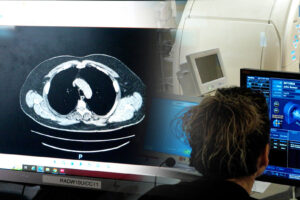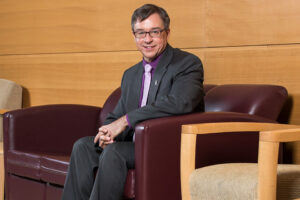UMB opens innovation space at the Biopark
Published 12/7/17 in the Daily Record
From left, University of Maryland, College Park President Wallace Loh; University System of Maryland Chancellor Robert Caret; and University of Maryland, Baltimore President Jay Perman at Thursday’s event launching the Graduate Research Innovation District at the University of Maryland BioPark. (Maximilian Franz)
The University of Maryland, Baltimore launched its Graduate Research Innovation District at the University of Maryland BioPark Thursday, a space that university leaders hope spurs student startups while also acting as a resource for the southwest Baltimore community.
The GRID in the Lions Brothers building will house a 6,200-square-foot space, entrepreneurial services and education for university faculty, students and technology companies. It looks and feels like somewhere a startup would locate, with an open floor plan, exposed brick and large windows providing a lot of natural light.
“We don’t have anything like this kind of space at the university,” said Jay A. Perman, president of the University of Maryland, Baltimore. “These startups aren’t vanity projects. They’re serious companies raising serious money and moving complicated medical technologies to market.”
The building will also look to increase collaboration between the University of Maryland’s Baltimore and College Park campuses, a partnership formalized last year by the Maryland General Assembly.
Some of that partnership has taken the form of UM Ventures, which helps move research done at the university through the tech transfer process. With offices on both the Baltimore and College Park campuses, UM Ventures has accelerated the number of startups spun out of university technology.
But so far, most of that has been focused on faculty research and innovation. With the GRID, the university hopes that it can bring more student-focused companies through the startup process.
“Over the last three or four years we have been more engaged with our students, and they have been more engaged with us at the UMB campus,” said Jim Hughes, director of UM Ventures and the University of Maryland, Baltimore’s vice president and chief enterprise and economic development officer. “This, in part, is an outgrowth of the students saying we would like more entrepreneurial opportunities. They came to us with a plan and request, and this is partly a response to that.”
Wallace Loh, president of the University of Maryland, College Park, said the connection between the two schools will help to serve the economic goals of the state.
“We are innovation universities,” he said. “That artery, that connection between the University of Maryland, College Park and the University of Maryland, Baltimore along I-95, that is the backbone for innovation and entrepreneurship in the state of Maryland.”
Loh said the collaboration between the two universities will soon be enhanced by buses running between the two campuses along the interstate.
For the state, the enhanced focus on innovation has been important for the economy as well. Loh reminded the crowd gathered for the building opening that the University of Maryland was founded as an agricultural institution and later the economy was powered by industrial jobs.
As universities operate in the 21st century, they have to help the economy adapt to its new challenges, he said.
“I think this also demonstrates that universities are fulfilling their goal of being not just educators but also drivers of the economy,” said Benjamin Wu, assistant secretary of commerce.
While the GRID was created under the University of Maryland banner, it will also serve as a community hub.
The university plans to make its resources in the Lions Brothers building available to the entire community and to enter into community partnerships. The space will serve food and drinks from Culinary Architecture Cafe, a growth of a Pigtown business that became connected to the university through its local contracting initiatives.
The building also houses an office of the Small Business Development Center, with resources available to all small businesses, not just university startups.




